Quick search
CTRL+K
Quick search
CTRL+K
Karoumes beach, a serene and secluded area, is situated 110km east of Agios Nikolaos and 29km southeast of Sitia. The beach is nestled at the end of the picturesque Chochlakies gorge, a part of the E4 trail. The only way to reach the beach is by trekking through the gorge, as the rough terrain of the region doesn’t permit road access. To get there, you need to park your car in the charming village of Chochlakies and embark on the trail that begins 1km east of the village. The gorge spans 3.5km and is filled with water until springtime. The hike generally lasts 1.5 hours at a relaxed pace and is only feasible when it hasn’t rained. The trail alongside the river offers stunning views as the gorge, with its towering cliffs, weaves through the barren mountains. During the trek, you’ll encounter numerous ponds (in spring) and a vast variety of flora. As you approach the exit, the high cliffs transition into a small valley.
At the valley’s edge, you will discover the tranquil Karoumes beach. This beach features small pebbles, and its eastern orientation ensures calm waters. It’s also home to numerous trees providing shade, and some rocks on the beach’s northern side. The beach’s remote location and challenging access make it an ideal spot for solitude. For those seeking even more isolation, there are two hidden beaches, each only 3-5m long, located 300m and 400m south of the main beach.
Approximately 700m north of Karoumes beach, on the trail from Karoumes to Agathias (near Palekastro), you’ll find an incredible sandy beach called Mavromouri Cape. This beach, surrounded by rugged hills and dotted with rocks in the sea, is well-shielded from waves and wind. Rock recesses offer shade to the few visitors, who typically reach the beach by boat.
If you venture to Karoumes, don’t miss the Pelekita cave, situated 3km south of the beach. Near the cave is an ancient quarry, formerly used for building the Minoan palace in Kato Zakros. Be sure to bring torches if you plan to explore the cave’s interior. From the cave, you can continue south to Kato Zakros via the E4 trail. Alternatively, you can trek from Agathias to the three Skinias beaches and then stroll south along the coastline until you reach Karoumes.

Skinias, a secluded region, is situated 94km to the east of Agios Nikolaos and 20km to the east of Sitia, nestled in one of Crete’s most remote eastern corners. This wild terrain is home to three charming little coves, perfect for anyone seeking solitude, located at the end of the Katsara gorge. With no amenities or shade-providing trees in sight, visitors should be prepared with water and an umbrella.
Access to the beach is through a challenging dirt road that leads to the central beach of Skinias. Those with a standard vehicle will need to halt before reaching the beach due to the poor road conditions. The first beach you encounter is the central sandy beach of Skinias, renowned for its stunning water hues. This pebble-strewn beach is recommended for snorkelling and fishing activities. If you tread 200m to the east, following the rocky coastline dotted with numerous caves and vibrant blue waters, you will soon arrive at the eastern pebbly beach of Skinias. Conversely, if you head west from the central beach towards Karoumes, you will find another pebble beach, born from the mouth of a brief, small canyon.
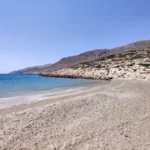
Situated 91 km east of Agios Nikolaos, 22km east of Sitia, and 2km east of the quaint town of Palekastro, Chiona is a beautifully serene sandy beach. Its pristine white sand and crystal-clear shallow blue waters make it a popular spot despite its relatively small size.
The name ‘Chiona’ translates to ‘carob storehouse’ in the local Cretan dialect, a nod to the storage facilities that were typically built near Cretan beaches for transferring carobs via ship due to the lack of roads. Indeed, the area was traditionally known for its carob trade.
Visitors to Chiona can enjoy a perfect day out, especially when combined with a meal at the renowned local fish taverns. While the beach offers minimal facilities (primarily near the taverns), there are tamarisk trees along the coast that provide a respite from the sun. To the east of the main beach, several secluded coves offer a peaceful spot for swimming, including the first sandy beach, Bondalaki, which is possibly the best in the entire area.
From Chiona, one can spot the small Grandes islands. Just beside the beach, in the location of Roussolakkos, the remains of an ancient Minoan port and settlement can be explored. Heading north from Chiona will bring you to the lengthy Kouremenos beach, Crete’s most famed spot for windsurfing. Lastly, a walk to the peak of the hill Kastri, located at the west end of the beach, will reward visitors with stunning views of the sea and the remnants of an old fort.
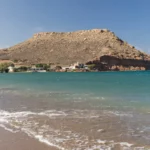
Kouremenos, situated 91km east of Agios Nikolaos and 21km east of Sitia, is just a kilometer east of the quaint town of Palekastro. Palekastro offers a wider variety of accommodation, dining, and entertainment options, but there are also several new hotels near the beach for your convenience. The beach itself is the longest in the region, stretching over 1.5km and framed by Cape Tenta to the north and Cape Plaka to the south. With its fine brown sand, shallow turquoise waters, and abundant tamarisk trees, it’s a stunning location. Amenities such as umbrellas, showers, and beach bars are available in certain areas.
The real allure of Kouremenos, though, is the strong wind that constantly sweeps the area, making it a hotspot for windsurfers and kite surfers from all over Europe. This is why it’s home to some of Greece’s largest wind turbine parks.
Windsurfing at Kouremenos is an experience not to be missed. A windsurfing school operates on the beach, offering equipment rentals at reasonable prices. The Meltemi, or northwest summer wind, is particularly strong here due to local thermal and funnelling effects, creating ideal conditions for windsurfing with an average wind force of around 6 Beaufort during the summer season.
The beach is suitable for windsurfers of all skill levels. The flat, shallow waters near the coast are perfect for beginners, while further out, the small waves provide a challenge for more experienced surfers. There’s also a rocky area at the northern end of the beach where experts can show off their skills. The local school has even installed buoys to indicate the entry point.
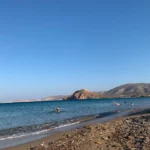
To the east of Hiona’s primary beach, you’ll find numerous tiny inlets where you can swim in solitude and without clothing. The first sandy coast, known as Bondalaki, is arguably the most stunning. If you continue eastward along a rough dirt road towards Cape Plaka, you’ll soon encounter a series of pebbled inlets set against an uncanny landscape of chasms and rugged mountains. The final inlet, Skaria, is Crete’s furthest eastern beach, significantly impacted by sea currents, resulting in an unfortunate amount of litter. The beach before this, Pilos, is set in clay terrain and is the perfect spot for privacy.

Maridati, nestled in the verdant valleys of Palekastro, is a stunning pebbly beach. It’s situated 90km to the east of Agios Nikolaos, 21km east of Sitia, and 5km to the north of the renowned Kouremenos windsurfing beach. The beach, rather short in length, is encompassed by two rocky capes. This secluded spot offers a peaceful escape from the bustling crowds, perfect for a tranquil swim.
Not far from the beach, about 50 meters away, you’ll find a small wetland filled with fresh water that serves as a haven for various bird species. You’ll also come across several tamarisk trees in the vicinity.
In historical times, the springs and torrent of Maridati used to draw the attention of Venetian ships.
Reaching Maridati by car from Palekastro is straightforward. Take the road to Vai and look out for a sign to Maridati on your right, approximately 5km from Palekastro. From there, you’ll need to navigate a 1.5km dirt track. Despite its rough terrain, the path is in good condition and the breathtaking beauty of Maridati is well worth the journey!
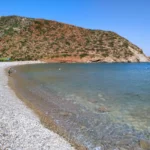
Kato Zakros, a quaint fishing village, is nestled 107km east of Agios Nikolaos and 40km east of Sitia. It serves as the scenic port of Ano Zakros village, which is located 7km to the west, amidst a fertile valley bordered by rugged mountains and lush olive groves. This remote corner of Crete provides the perfect escape for those seeking tranquillity and an escape from the bustling city life, making it a favourite among families.
The village, though small, offers all the fundamental amenities without the trappings of luxury. The villagers primarily focus on the production of world-class olive oil. Rich in archaeological sites, including the renowned Minoan palace of Zakros, the village retains its natural beauty with limited construction. However, you will find a few accommodations, taverns, mini markets, pharmacies, and petrol stations. Regular bus services from Sitia also connect the village. The warm and welcoming locals will make you feel right at home.
The serene beach fringing the village is nestled within a large protected bay. Comprising mainly pebbles and occasional rocks, the beach boasts tranquil waters, offering a peaceful retreat even during the busy month of August. The rocky seabed is a paradise for fishing enthusiasts.
When in Kato Zakros, the famous Gorge of Zakros, ominously known as Deads’ Gorge, is a must-visit. Named after the many Minoan graves discovered within its cavernous sides, the gorge offers an adventurous hike from Zakros village that takes around two hours. The Minoan palace of Zakros, the fourth largest after Knossos, Phaestus, and Malia, is a significant archaeological site located near the gorge’s exit. It houses numerous artistic masterpieces from 1900BC and is open to the public, with the most significant findings displayed at the Archaeological Museum of Heraklion.
An old dirt road leading to Zakros, offering breathtaking views of the Gorge’s steep cliffs, is worth exploring if you have a car. Upon reaching the village, take a leisurely stroll through its narrow streets and visit its churches. The springs of Zakros, forming a small oasis amidst the wild landscape of Eastern Crete, are also worth a visit.
If time permits, a boat trip (or rigorous hike) to the secluded Cave of Pelekita could be an exciting expedition. As one of Crete’s largest caves, it has traces of Neolithic habitation. A nearby quarry, presumably used by the Minoans for constructing the palace of Zakros, is also an interesting sight.

As a resident of Crete Island, if you venture north of Maridati along the rugged coastline until you reach the Vai palm grove, you’ll discover a number of isolated, small coves. These hidden gems can only be reached either by boat or a 2:30-hour hike on foot. The initial beach you encounter goes by the name of Kokkinos Kavos, or Red Cape, a moniker it acquired due to the area’s reddish rocks. The beach features a mix of sandy and pebbly patches along its seabed.
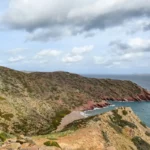
As a resident of Crete island, if you stroll along the northern coastline from Maridati to the Vai palm grove, you’ll encounter numerous secluded tiny coves, only accessible by boat or foot (a 2:30 hour journey to Vai). Midway between Maridati and Vai, you’ll find the most stunning beach, Kedromouri. Named after the juniper trees that adorn it, Kedromouri translates to junipers’ cape.

The picturesque Psili Ammos beach, situated near the renowned Vai palm beach, is about 95km east of Agios Nikolaos and 25km east of Sitia. A brief stroll from Vai, across the eastern hill, leads you to this hidden gem. The beach, with its fine sand and crystal clear waters, is often deserted, making it a perfect spot for solitude and naturism.
Psili Ammos, translating to ‘fine sand’ in Greek, is an apt description of the sandy stretch that defines the area. The beach takes shape at the end of this narrow sand strip, and its turquoise-green waters make it one of the most beautiful secluded spots on Crete. Lack of large trees necessitates carrying an umbrella for shade. Hunger pangs can be satiated at the nearby Vai canteen. The area is a protected zone owing to the rare Vai palm forest, hence tourist facilities like taverns, hotels and rooms are scarce.
A walkway from Psili Ammos heads south, leading to Maridati beach after a 2.5-hour walk. This trail is dotted with numerous small coves and their accompanying secluded beaches. The first one encountered is recognized for its stunning rock formations.
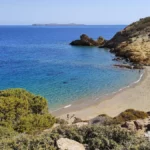
No results available
Reset© All rights reserved. Crete Locals